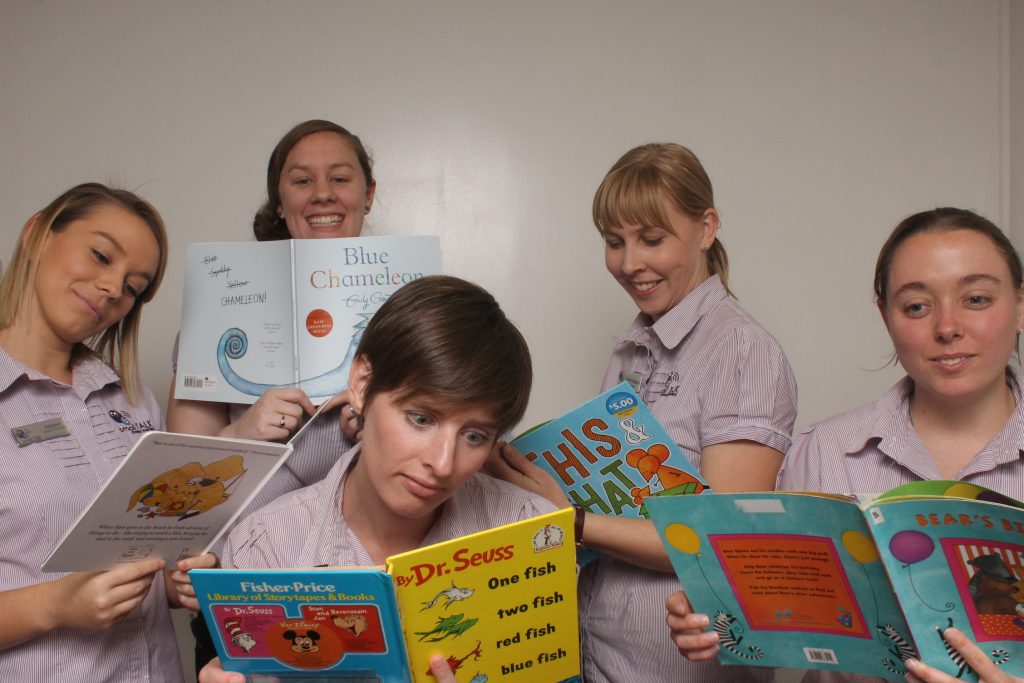What is Phonological Awareness?
Phonological awareness is the ability to hear, identify and say the separate parts of words such as rhymes, and letter sounds. Phonemic awareness is a sub-skill of phonological awareness. It is the ability to identify, say and manipulate the smallest sounds in words (phonemes).
The terms phonological awareness and phonemic awareness are sometimes interchanged even in academic papers, so it is not surprising that there is much confusion about their meanings.
Let’s clear up some of the confusion!
Phonological awareness can be considered an umbrella term, with phonemic awareness as one of the skills that comes under that umbrella.
Phonological Awareness Skills
- Recognising when words rhyme (e.g., “Do ‘cat’ and ‘shoe’ rhyme?”)
- Coming up with a word that rhymes (e.g., “What rhymes with ‘key’?”)
- Segmentation of words in sentences (e.g., “Clap for each word you hear in the sentence ‘The dog is furry.’”)
- Blending syllables (e.g., “I am going to say parts of a word. Tell me what the word is. ‘Pan-da.’”)
- Segmentation of syllables (e.g., “Clap for each syllable you hear in the word ‘refrigerator.’”)
- Deletion of syllables (e.g., “Say the word ‘strawberry. Now say it without saying ‘straw.’”)
- Identifying sounds in words (e.g., “What sound do you hear at the end of ‘tulip’?”)
- Blending sounds (e.g., “Put these sounds together to make a word. ‘D-oo-r.’”)
- Segmentation of sounds (e.g., “Tell me each sound you hear in the word ‘cat’?”)
- Deletion of sounds (e.g., “Say ‘chair.’ Now say it without the ‘ch.’”)
- Addition of sounds (e.g., “Say ‘cook.’ Now say it with an ‘e’ at the end.”)
- Manipulation of sounds (e.g., “Change the ‘s’ in ‘sad’ to a ‘d’ and say the new word.”)
Why is Phonological Awareness Important?
Phonological awareness is important because it is a basis for reading and literacy skills. Children begin to read by listening to others read aloud, then recognising sounds in words, sounding words out for themselves, recognising familiar words, and so on. By engaging in word play, children learn to recognise patterns among words and use this knowledge to read and build words. Phonological awareness has been shown in numerous studies to be one of the best predictors of initial reading progress. For more tips on reading with your child see our blog.
How can phonological awareness be improved?
Fortunately, phonological awareness is a learned skill so it can be taught. While some kids learn more quickly, others need more time and attention. If a child is struggling, activities that build sound skills — reading stories or singing songs with rhymes, practicing the alphabet by pointing out letters wherever you see them, playing word games — will help grow their phonological awareness. Parents should also check with teachers to ensure the school’s reading program includes the development of phonological awareness skills. With improved phonological awareness, children can perform better in reading, writing and overall learning. For more on literacy see our For the Love of Literacy blog.
10 Fun Phonological Awareness Activities
- Sing nursery rhymes with your child at home, in the car, or out and about. Nursery rhymes teach your child language, rhyme, repetition and rhythm.
- Games that encourage children to identify words that begin with a specific letter sound. For example, say, “I spy with my little eye a colour that starts with /r/.”
- Become a robot leader! Say this rhyme in a robot voice, sound out simple words, and have your child respond: “I am a robot. Can you help me? Can you tell me what I see? I see a /c/ /a/ /p/.” Encourage your child to repeat the rhyme in “robot talk” and then blend the final word to answer the robot’s question.
- Teach your child the separate sounds in their name. For example, ‘Tom’ has three sounds – ‘t – o – m’.
- Choose a sound and play the game ‘I went to the shop and I bought…’ For example, (using the sound /p/) ‘I went to the shop and I bought a puppy. I went to the shop and I bought a puppy and a pie’.
- For a trickier version, the next item must start with the last sound in the previous item. ‘I went to the shop and I bought a cup. I went to the shop and I bought a cup and a pig.’
- Mystery bag – fill with familiar objects, the child pull out an object, name it, clap the syllables – e.g. ‘lion’ – li-on, ‘ball’ – ball, ‘octopus’ – oct-o-pus
- When reading books to your child that contain rhyming words, emphasise the rhyming words as you read. Dr. Seuss books are great for this activity. See our We Love Books blog for more of our favourite books.
- Buy inexpensive beads and string at a craft store. Give your child some string and beads and have them tie a knot at one end. Say a word and have your child string one bead for each sound they hear in the word
- Guess-the-word game- Say a word broken up into sounds (e.g. mmmm-ooo-nnn) and have your child guess what word it is (e.g. moon).
Useful Links
http://www.readingrockets.org
https://speldnsw.org.au/
https://www.fivefromfive.org.au
https://education.nsw.gov.au/
https://www.learningpotential.gov.au/learning-to-read-1-phonemic-awarenessS
Speech Pathology Australia Factsheets
Have more questions? Get in touch with our friendly team to find out how a Speech Pathologist can help with your child’s Phonological awareness and literacy skills.



